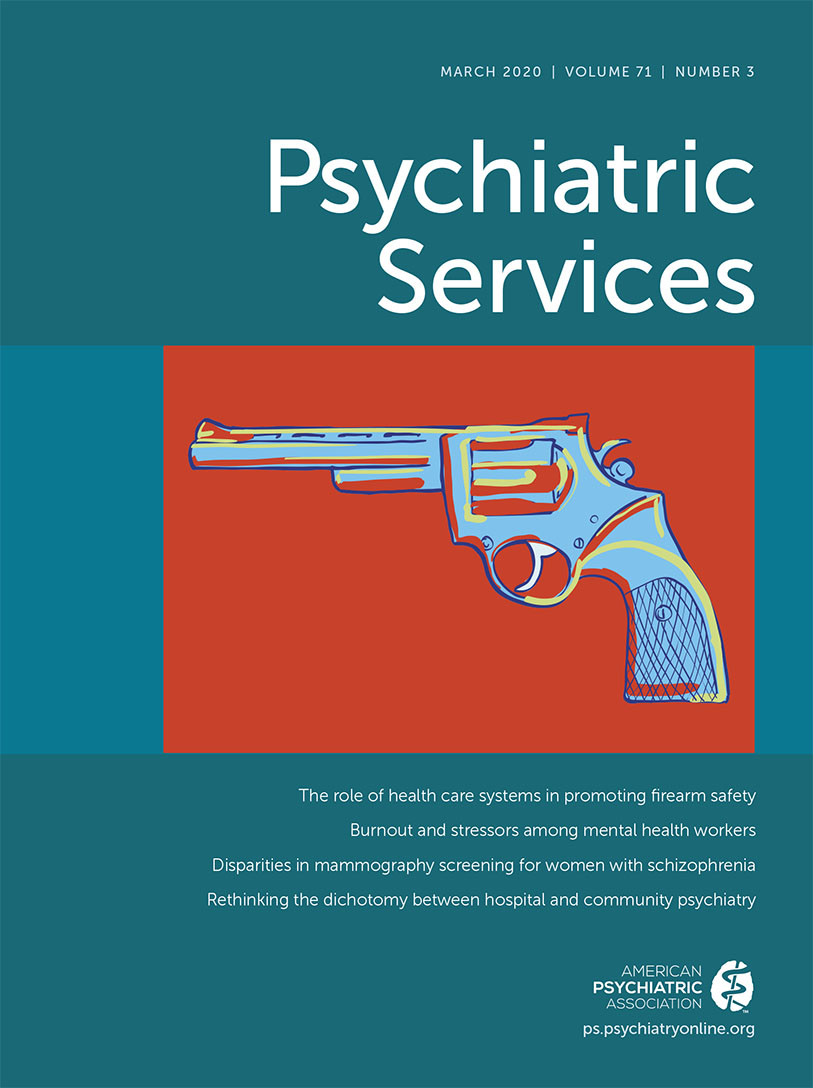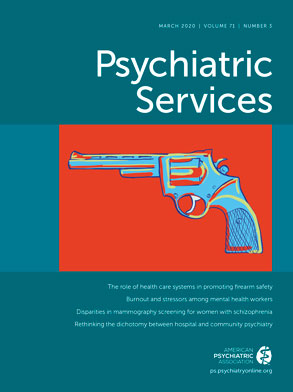Past suicide attempt is a leading risk factor for suicide, and most suicide attempts involve an overdose of prescription or nonprescription medications (
1). Community pharmacists are responsible for the safe and judicious distribution of these medications, which provides them with the opportunity to intervene when presented with someone at risk of suicide (
2). Although this has long been recognized as an important role of pharmacists and community pharmacies, research regarding this role is limited (
3–
8). To determine pharmacists’ experiences with supporting patients with suicidal thoughts, plans, and attempts, we conducted a two-country survey.
Methods
An online survey using Opinio (
https://surveys.dal.ca) was developed and administered to Canadian and Australian community pharmacists. The survey had four sections: general demographic characteristics, the Attitudes Toward Suicide (ATTS) (
9) scale, the Stigma of Suicide Scale (SOSS) (
10), and a section to collect data on pharmacists’ experiences with patients at risk of suicide or who had died by suicide. The SOSS analysis is complete (
8), and the ATTS analysis is underway. This collaboration among investigators from both countries occurred as a result of a shared interest in examining and advancing mental illness and addictions care in community pharmacy settings.
Ethical Approval
The study was approved by the Dalhousie University (2016–3832) and the University of Sydney (2016/464) research ethics boards.
Target Sample and Recruitment
Community pharmacists in Canada and Australia were eligible. Recruitment occurred from June 2016 to April 2017 via e-mail, direct telephone contact, social media, and word of mouth and at professional meetings. We contacted provincial and state professional associations, who then shared the invitation to participate in the survey with their members. We also contacted local pharmacy groups directly and informed pharmacy conference attendees about the survey. When possible, up to two reminders were sent. Pharmacists were offered entry in a gift card draw ($150 [Canadian]) for participation.
Sample Size
A sample of 300 participants (N=150 per country) was calculated to support a 95% confidence interval of no greater than ±6% for our survey estimates of the proportion of responses for each descriptive statistic.
Data Analysis
Descriptive statistics were used to characterize demographics. Continuous data were summarized as means and standard deviations, and categorical data were presented as frequencies with percentages. Comparisons between countries were made by using Fisher’s exact test and t test as appropriate. Multivariable logistic regression was used to determine the relationship between variables and pharmacists’ preparedness to help a person in a suicidal crisis (a complete list of the variables included in the regression analysis is available as an online supplement to this report). Logistic model assumptions were assessed with Hosmer and Lemeshow goodness of fit. All analyses were performed by using SAS, version 9.4, with an alpha level of 0.05. Only significant results from the regression are reported in the text.
Results
Of the 396 pharmacist respondents, 235 were from Canada and 161 were from Australia. Most respondents were female (N=276, 70%) and currently practicing in community pharmacy (N=343, 87%). Significantly more Australian (N=46, 29%) than Canadian (N=27, 12%) pharmacists reported completing training for supporting people in a mental health crisis (p<0.001). Forty-seven percent (N=110) of Canadian and 41% (N=66) of Australian pharmacists reported directly interacting on at least three or more occasions with people they thought were at risk of suicide. In both countries, nearly one in 10 pharmacists reported having interacted with someone at risk of suicide more than 10 times (a full tabulation of participant demographic characteristics and their experiences with patients at risk of suicide can be found in the online supplement).
Three hundred twenty-four pharmacists provided information on their most prominent experience with someone at risk of suicide. What constituted the most prominent experience was left to the respondent’s interpretation. Most pharmacists (N=213, 66%) reported that concerns arose for the patient because the patient directly indicated having thoughts of suicide. Fewer pharmacists (N=44, 14%) directly inquired to ascertain this information. In assessing the person, most pharmacists (N=244, 75%) determined the existence of thoughts of suicide, but approximately 40% or fewer inquired about plans, intentions to carry out plans, and access to means to carry out plans. Approximately 60% (N=194) of the sample reported feeling uncomfortable to very uncomfortable about their involvement after the situation, and 25% (N=81) felt dissatisfied to very dissatisfied with their management of the situation.
Lack of training and not knowing what to do (N=243 [65%] and N=234 [63%], respectively; total, N=371) were viewed as moderate to significant barriers to supporting or caring for a patient perceived to be at risk of suicide. Overall, 43% (N=161) of the 371 pharmacists who responded regarding barriers reported lack of confidence as a moderate to significant barrier. Lack of time was endorsed less often as an important barrier. Lack of private space was more often an issue for Australian respondents (for details, see the online supplement).
Approximately 58% (N=228) of 395 pharmacists strongly agreed or agreed that they were prepared to help a person in a suicidal crisis. In the multivariable regression analysis, being Canadian (odds ratio [OR]=0.13, 95% confidence interval [CI]=0.06–0.27; p≤0.001), having a patient who died by suicide (OR=0.48, 95% CI=0.23–1.00; p=0.049), lacking training (OR=0.42, 95% CI=0.18–0.97; p=0.043), lacking confidence (OR=0.33, 95% CI=0.16–0.69; p=0.003), and permissive attitudes toward suicide (OR=0.92, 95% CI=0.87–0.97; p<.001) were negatively associated with preparedness to help someone in a suicidal crisis. The belief that suicide is preventable was positively associated with being prepared to help a person in a suicidal crisis (OR=1.45, 95% CI=1.30–1.62; p<.001).
Discussion
Most pharmacists (N=335, 85%) in our sample reported interacting at least once with someone at risk of suicide, which is significantly higher than self-reports from recent research (
7). Nearly two-thirds of disclosures regarding suicidal thoughts were volunteered by patients to pharmacists. This finding has direct implications for suicide prevention frameworks. Restricting lethal means (e.g., medications) is fundamental to suicide prevention (
11), and pharmacists can have a direct role in this risk mitigation strategy. However, when patients disclosed suicidal thoughts, pharmacists’ information gathering focused on those thoughts and less on patients’ plans, intentions to carry out plans, and means to follow through on plans.
The interpretation of self-reported data on experiences obtained via survey methods has inherent limitations, including the potential for biases (e.g., self-selection bias, nonresponder bias). Nonetheless, these findings generate important questions about whether pharmacists know what to do and when to intervene and whether they have the confidence, knowledge, and skills to act when someone discloses suicidal thinking, plans, behaviors, and access to means. Lack of confidence was reported by more Australian pharmacists as a moderate to significant barrier to supporting or caring for someone at risk of suicide, and this variable was negatively associated with perceived preparedness to help someone in a suicidal crisis. Pharmacists’ confidence issues have previously been reported for difficulties starting conversations and intervening with people at risk of suicide (
2). Other researchers have reported that pharmacists may prefer a more secondary role in suicide prevention (
7), which may, in part, be the result of a lack of confidence. More than 60% of our sample reported not knowing what to do as a moderate to significant barrier to supporting or caring for someone at risk of suicide. However, unlike lack of training, not knowing what to do was not associated with pharmacists’ perceptions of preparedness to help someone in a suicidal crisis. More Australian pharmacists reported some form of training to support people in a mental health crisis, albeit not suicide specific. Notably, in the multivariable analysis, being Australian was positively associated with perceptions of preparedness to help someone in a suicidal crisis.
Education and training are typically the most commonly used interventions for overcoming concerns with lack of training and confidence, but they have mixed effects among pharmacists. For example, previous suicide prevention training for pharmacists in one U.S. state was associated with less confidence in identifying the signs of suicide risk (
4). A recent literature synthesis in this area further demonstrated that education and training in suicide may have a positive impact on health care professionals’ knowledge of, confidence in preventing, and attitudes toward suicide, but the impact on behaviors and patient outcomes remains unknown (
12). The potential for discordant relationships among these variables (e.g., confidence, knowledge) compared with behaviors is well known (
12) and can be demonstrated through the use of objective evaluation measures (e.g., simulated patients). For example, El-Den et al. (
5) surveyed pharmacy students after suicide education and training. The majority of students had an inflated level of confidence, which contrasted with their ability to consistently use appropriate terminology when inquiring about suicide in a simulated patient scenario (
5).
Gatekeeper training is recommended in suicide prevention frameworks (
13) and in regional prevention approaches in various countries (
14) as an important prevention strategy, although controversy exists and some uncertainties remain regarding its benefits (
15). Gatekeepers are those “likely to come into contact with at-risk individuals . . . influential in a suicidal person’s decision to access care . . . [and] in a position to carry out informal observation of an individual, detect risk, and provide assistance” (
13). Suicide-specific gatekeeper training for pharmacists and pharmacy teams (e.g., technicians, assistants) and related changes to community pharmacy environments and practices that support suicide prevention should be developed and evaluated. The pedagogical approach to pharmacy team gatekeeper training requires consideration because exploration of mechanisms to incorporate and address pharmacists’ previous experiences with patients who have died by suicide and pharmacists’ attitudes (e.g., beliefs about whether suicide is preventable and permissible) is important. On the basis of our results, these factors may be associated with perceived preparedness to help someone in a suicidal crisis. Using simulated patients with lived experience of suicidal thinking, plans, and behaviors is a promising method for facilitating meaningful feedback on skills and behaviors and for supporting sustained retention of knowledge among pharmacists (
6).
Last, gatekeeper training is but one component of suicide prevention frameworks (
11,
13) and should be implemented for pharmacists and other primary care providers in the context of a comprehensive suicide prevention framework with evidence-based strategies (e.g., means restriction). Evaluation of the impact of suicide gatekeeper training for pharmacists and its impact on patients and pharmacists over time is also required.

